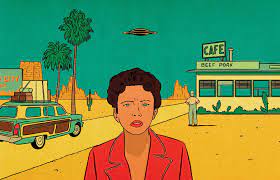by KEM Huntley
The short story does not usually lend itself to a Dramatica Grand Argument. Moreover, there often is not enough “real estate” to properly explore all four throughlines. Nevertheless, it can be done. In answering key Dramatica questions, an analysis of James Thurber’s satire, The Catbird Seat, provides an example.
1. What is the title of the story?
The Catbird Seat
2. In a short paragraph, describe what The Catbird Seat is about.
This short story explored the horrors of “downsizing” long before the term became a fashionable catchword for the elimination of jobs and subsequent mass firings of loyal employees who often don’t see it coming. However, if you are one of those with an eye on the ball and few tricks up your buttoned-down shirt sleeve, you may just end up sitting pretty in the catbird seat.
3. Who is the author?
James Thurber
4. Where does the story take place?
New York, early 1940’s
5. Determine and describe the main character-the figure with whom the reader will most identify.
Mr. Erwin Martin: “Cautious, painstaking” (239)
6. Determine and describe the Impact Character-the figure that will have the most bearing on the main character.
Mrs. Ulgine Barrows: “Her quacking voice and braying laugh . . . . had appalled Mr. Martin instantly, but he hadn’t shown it. He had given her his dry hand, a look of studious concentration and a faint smile. ‘Well,’ she said, looking at the papers on his desk, ‘are you lifting the oxcart out of the ditch?’ Later: “The faults of the woman as a woman kept chattering on in his mind like an unruly witness. She had, for almost two years now, baited him. In the halls, in the elevator, even in his own office, into which she romped now and then like a circus horse, she was constantly shouting these silly questions at him. “. . . Are you tearing up the pea patch? Are you hollering down the rain barrel? Are you scraping around the bottom of the pickle barrel? Are you sitting in the catbird seat?’ . . . Mr. Martin dismissed all this with an effort. It had been annoying, it had driven him near to distraction, but he was too solid a man to be moved to murder by anything so childish.” (239-40)
7. Determine and describe all the characters concerned with the overall story.
- Mr. Erwin Martin-particular and remarkably efficient in his work; model employee
- Mrs. Ulgine Barrows-loud, vulgar, crass; she has quite a lot of power
- Mr. Fitweiler-the susceptible boss that is taken in by Barrows
- Old Roberts-personnel chief
- Joey Hart-assistant to Mr. Martin
- Miss Paird-assistant to Mr. Martin; she is not above eavesdropping for Mr. Martin’s benefit
- Miss Tyson-ex-employee
- Mr. Brundage-ex-employee
- Mr. Bartlett-ex-employee
- Mr. Munson-ex-employee
- Dr. Fitch-Mr. Fitweiler’s psychiatrist
- Stockton-employee
- Fishbein-employee
- Mrs. Powell-employee
8. At the end of the story, has the Main Character changed or remained the same (MC Resolve)?
Mr. Martin is steadfast in his drive to maintain his filing department and his position as its head.
9. Does the Main Character need to grow out of something (Stop) or grow into something (Start)?
Mr. Martin must stop the madness that is Mrs. Ulgine Barrows.
10. What is main character’s approach to solving problems? Does he at first confront a dilemma head-on (Do-er), or does he adapt himself to the situation at hand (Be-er)?
Although quiet and unassuming, Mr. Martin is nevertheless a do-er. Once Mr. Martin believes his department is Mrs. Ulgine Barrow’s next target he knows: “He must act quickly. . . . Mr. Martin stood up in his living room, still holding his milk glass. ‘Gentlemen of the jury,’ he said to himself, ‘I demand the death penalty for this horrible person'” (241).
11. Determine and describe the main character’s use of linear or holistic problem– solving techniques.
Mr. Martin uses linear thinking to solve his problems. Not only is his daily life extremely routine, his plan to “rub out” Mrs. Ulgine Barrows is done step by step.
12. Determine and describe the actions or decisions that drive the plot forward.
Actions drive the plot forward, first described in the backstory:
. . . Mrs. Barrows had met Mr. Fitweiler at a party, where she had rescued him from the embraces of a powerfully built drunken man who had mistaken the president of F & S for a famous retired Middle Western football coach. She had led him to a sofa and somehow worked upon him a monstrous magic (impact character domain-psychology). The aging gentleman had jumped to the conclusion (overall story symptom-deduction) there and then that this was a woman of singular attainments . . . . A week later he had introduced her into F & S as his special advisor (overall story response-induction). (240)
Later, Mrs. Barrows’ actions are the cause of Mr. Martin’s decision “to rub out Mrs. Ulgine Barrows. The term ‘rub out’ pleased him because it suggested nothing more that the correction of an error-in this case an error of Mr. Fitweiler” (239).
13. Determine and describe how the story has reached its conclusion (Story Limit). Is it because time has run out (Timelock), or because all the options (Optionlock) are exhausted?
Mr. Fitweiler has the option to either believe Mrs. Ulgine Barrows or Mr. Martin’s account of what had transpired between the two in determining which one will remain employed at F & S:
“Mrs. Barrows is under the delusion (impact character domain-psychology),” continued Mr. Fitweiler, “that you visited her last evening and behaved yourself in an-uh-unseemly manner.” He raised his hand to silence Mr. Martin’s little pained outcry. “It is the nature of these psychological diseases,” Mr. Fitweiler said, “to fix upon the least likely and most innocent party as the uh-source of persecution. These matters are not for the lay mind to grasp, Martin. I’ve just had my psychiatrist, Dr. Fitch, on the phone. He would not, of course, commit himself, but he made enough generalizations to substantiate my suspicions. I suggested to Mrs. Barrows, when she completed her-uh-story to me this morning, that she visit Dr. Fitch, for I suspected her condition at once. She flew, I regret to say, into a rage, and demanded-uh-requested that I call you on the carpet. You may not know, Martin, but Mrs. Barrows had planned a reorganization of your department-subject to my approval, of course, subject to my approval (main character problem-reduction). This brought you, rather than anyone else, to her mind-but again that is a phenomenon for Dr. Fitch and not for us. So, Martin, I am afraid Mrs. Barrows’ usefulness here is at an end.”
“I am dreadfully sorry, sir,” said Mr. Martin. (244-45)
14. Is the outcome of the story a Success or Failure?
This is a success story. Mrs. Ulgine’s dismissal from F & S means the potential (overall story solution) for more departmental reorganization, therefore disruptions, is eliminated.
15. At the end of the story does the Main character feel Good or Bad (Judgment)?
Mr. Martin, without having to literally “rub out” Mrs. Ulgine Barrows has still effectively removed his nemesis, thus relieving his angst:
“I regret that this has happened,” said Mr. Fitweiler. “I shall ask you to dismiss it from your mind, Martin.” “Yes, sir,” said Mr. Martin, anticipating his chief’s “That will be all” by moving to the door. “I will dismiss it.” He went out and shut the door, and his step was light and quick in the hall. When he entered his department he had slowed down to his customary gait, and he walked quietly across the room to the W20 file, wearing a look of studious concentration. (245-46)
16. Describe the four points of view (domains): Overall, Main Character, Impact Character, and Relationship.
- Overall Story-Universe: F & S is a company that thrives on its systems-and will employ whatever methods to make certain it runs with the utmost efficiency.
- Main Character-Physics: Mr. Martin is a staunch defender of his department-even to the point of engaging in activities to “rub out Mrs. Ugline Barrows” (239)-the woman who threatens to dispense with it and he as its head.
- Impact Character-Psychology: Mrs. Ulgine Barrows is a master manipulator. She has Mr. Fitweiler firmly under her thumb and the fate of the company in her hands.
- Relationship Story-Mind: Mrs. Ulgine Barrows is determined to eliminate Mr. Martin’s department; Mr. Martin is just as determined to keep it intact.
17. What is the Goal of the story? Describe.
How the “system” of F & S stands (Present) is the story goal. Although the company president, Mr. Fitweiler, has hired Mrs. Ulgine Barrows “to bring out the best in him and in the firm” (240), “. . . in Mr. Martin’s mind . . . . Mrs. Ulgine Barrows stood charged with willful, blatant, and persistent attempts to destroy the efficiency and system of F & S” (240).
18. What thematic conflict in the Overall Story is explored?
The workplace of F & S, has been in an uproar since the “. . . day confusion got its foot in the door” in the arrival of Mrs. Ulgine Barrows. Her attempts at reorganization, with no prior professional experience, are depicted negatively, whereas those who are suited for the task at hand are shown in a positive light (work vs. attempt).
19. What is the problem in the Overall Story?
Mr. Fitweiler’s total reliability on Mrs. Ulgine Barrows’ judgment (certainty) creates problems for the employees of F & S:
After Miss Tyson, Mr. Brundage and Mr. Bartlett had been fired and Mr. Munson had taken his hat and stalked out, mailing in his resignation later, old Roberts had been emboldened to speak to Mr. Fitweiler. He mentioned that Mr. Munson’s department had been “a little disrupted” and hadn’t they perhaps better resume the old system there? Mr. Fitweiler had said certainly not. He had the greatest faith in Mrs. Barrows’ ideas (impact character concern-conceiving). (240)
20. Describe what conflict (Concern) occurs in the four throughlines.
- Overall Story-Present: A self proclaimed efficiency expert has insinuated herself into F & S-and is wasting no time in having it run her way (overall concern thematic issue-expediency). It is a situation of concern to all involved: “She had begun chipping at the cornices of the firm’s edifice and now she was swinging at the foundation stones with a pickaxe” (240).
- Main Character-Learning: Mr. Martin is concerned to learn his department is next on Mrs. Barrows’ hit list; Mr. Martin is concerned that no one learns of his part in Mrs. Barrows’ “rubbing out.”
- Impact Character-Conceiving: Mrs. Ulgine Barrows is influential with her ideas: “Mr. Fitweiler . . . had the greatest faith in Mrs. Barrows’ ideas. ‘They require a little seasoning, a little seasoning is all'” (240).
- Relationship Story-Conscious: Considerations are the source of conflict between Mr. Martin and Mrs. Ulgine Barrows. Mr. Martin is sensible to the fact Mrs. Ulgine Barrows is contemplating a reorganization of his department which is problematic for him; Mrs. Ulgine Barrows underestimates Mr. Martin, not for a second taking his devotion to his department-and what he might do to protect it-into consideration.
21. Describe the sequence of events for the four throughlines (Signposts).
Overall story: In the past (Signpost 1) F & S was a staid, old firm operating quite efficiently, until the day:
[Mrs. Barrows’] . . . quacking voice and braying laugh had first profaned the halls of F & S on March 7, 1941. . . . It was competent, material, and relevant to review her advent and rise to power. Mr. Martin had got the story from Miss Paird, who seemed always able to find things out. . . . Mr. Martin came now, in his summing up, to the afternoon of Monday, November 2, 1942-just one week ago. On that day, at 3 P.M., Mrs. Barrows had bounced into his office. “Boo!” she had yelled. “Are you scraping around the bottom of the pickle barrel?” Mr. Martin had looked at her from under his green eyeshade, saying nothing. She had begun to wander about the office, taking it in with her great, popping eyes. “Do you really need all these filing cabinets?” she had demanded suddenly. (241) Much to Mr. Martin’s alarm, Mrs. Ulgine Barrows’ progress (Signpost 2) in turning F & S upside down includes the “reorganization” of his department. Mr. Martin shares his (phony) future (Signpost 3) plans with Mrs. Barrows that includes blowing up their boss. Once she reports his extremely out of character behavior to Mr. Fitweiler, her state of mind is questioned, and she is dismissed (Signpost 4-present). Mr. Martin is successful in stopping her from steam rolling his department and wreaking any further havoc at F& S.
Main Character: Mr. Martin bought the pack of Camels on Monday night in the most crowded cigar store on Broadway. It was theatre time and seven or eight were buying cigarettes. . . . If any of the staff at F & S had seen him buy the cigarettes, they would have been astonished, for it was generally known that Mr. Martin did not smoke, and never had (Signpost 1-obtaining). No one saw him. It was just a week to the day since Mr. Martin had decided to rub out Mrs. Ulgine Barrows. The term “rub out” pleased him because is suggested nothing more than the correction of an error-in this case an error of Mr. Fitweiler. . . . The project as he had worked it out was casual and bold, the risks were considerable. . . . And therein lay the cunning of his scheme. No one would ever see in it the cautious, painstaking hand of Erwin Martin, head of the filing department at F & S, of whom Mr. Fitweiler had once said, “Man is fallible, but Martin isn’t.” (239) Mr. Martin understands (Signpost 2) he must be very careful not to make any mistakes as: “If he ran into anybody, he would simply have to place the rubbing-out of Ulgine Barrows in the inactive file forever” (242). His plan is put into action (Signpost 3-doing) once he finds himself in her apartment: “Mr. Martin looked quickly around the living room for the weapon. He had counted on finding one there. There were andirons and a poker and something in a corner that looked like an Indian club. None of them would do. . . . When Mrs. Barrows reappeared, carrying two highballs, Mr. Martin standing there with his gloves on, became acutely conscious of the fantasy he had wrought. Cigarettes in his pocket, a drink prepared for him-it was all too grossly improbable. It was more than that; it was impossible. Somewhere in the back of his mind a vague idea stirred, sprouted. . . . The idea began to bloom, strange and wonderful. She put the glasses on a coffee table in front of a sofa and sat on the sofa. “Come over here, you odd little man,” she said. “Well,” she said, handing him his drink, “this is perfectly marvelous. You with a drink and a cigarette.” Mr. Martin puffed, not too awkwardly, and took a gulp of the highball. “I drink and smoke all the time,” he said. He clinked his glass against hers. “Here’s nuts to that old windbag, Fitweiler,” he said, and gulped again. The stuff tasted awful, but he made no grimace. “Really, Mr. Martin,” she said, her voice and posture changing, “you are insulting our employer.” (243) The following day, Mr. Martin learns (Signpost 4) his department will stay intact once Mr. Fitweiler deems Mrs. Barrows mentally incompetent, after she had reported a fantastic account of Mr. Martin’s evening visit.
Impact Character: Mrs. Barrows and her big ideas (Signpost 1-conceiving) are upsetting the apple cart at F & S. Her role (Signpost 2-being) as special advisor to the president has a profoundly negative effect on the company, and particularly on Mr. Martin. She comes dangerously close to becoming (Signpost 3) a corpse at Mr. Martin’s hands-but it is her self-righteousness that finally does her in. The concept (Signpost 4) that “such a drab, ordinary little man” (245) as Mr. Martin could cause her demise changes (impact character resolve) her from the office tyrant to a blithering idiot:
She stopped yelling to catch her breath and a new glint came into her popping eyes. . . . She glared at Mr. Fitweiler. “Can’t you see how he has tricked us, you old fool? Can’t you see his little game?” But Mr. Fitweiler had been surreptitiously pushing all the buttons under the top of his desk and employees of F & S began pouring into the room. “Stockton,” said Mr. Fitweiler, “you and Fishbein will take Mrs. Barrows to her home. Mrs. Powell, you will go with them.” Stockton, who had played a little football in high school, blocked Mrs. Barrows as she made for Mr. Martin. It took him and Fishbein together to force her out of the door into the hall, crowded with stenographers and office boys. She was still screaming imprecations at Mr. Martin, tangled and contradictory imprecations. (245)
Relationship Story: Whereas Mrs. Ulgine Barrows doesn’t give Mr. Martin a second thought (Signpost 1-conscious), Mr. Martin is very conscious of her threat to his department. He recalls (Signpost 2-memory) the description of her “ducky first-floor apartment” (242) as he makes his way to surprise her at home:
“‘Well, for God’s sake, look who’s here!’ bawled Mrs. Barrows, and her braying laugh rang out like the report of a shotgun. He rushed past her like a football tackle, bumping her. . . . ‘What’s after you?’ she said. ‘You’re as jumpy as a goat (Signpost 3-preconscious)'” (242). Instead of bumping Mrs. Barrows off, Mr. Martin acts out of character, fully cognizant that she will be driven to report his odd behaviour to Mr. Fitweiler the next day. She does, and to her great fury (Signpost 4-subconscious), finds Mr. Fitweiler thinks she’s crazy and her employment is terminated-much to the satisfaction of Mr. Martin.
Source Cited:
Thurber, James. “The Catbird Seat.” Studies in the Short Story. Ed. Adrian H. Jaffe and Virgil Scott. 3rd ed. New York: Holt, 1968. 239-246.



